
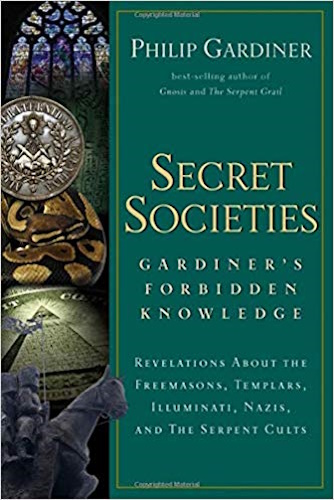







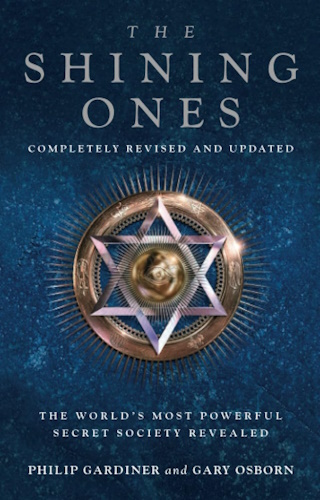

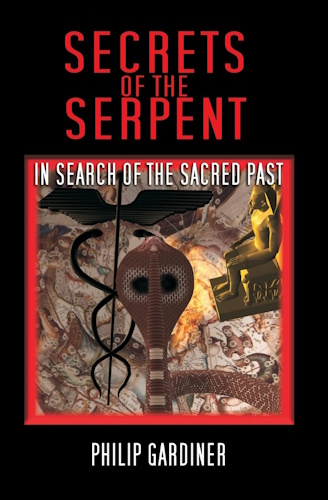

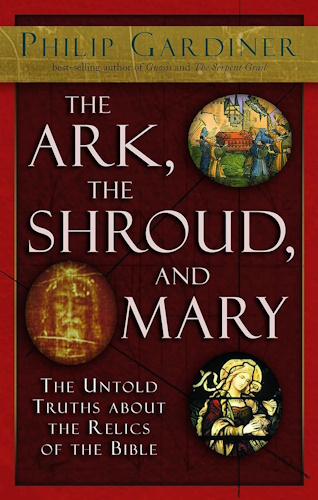


Secret Societies:
Gardiner's Forbidden Knowledge
Revelations About the Freemasons,
Templars, Illuminati, Nazis,
and the Serpent Cults
by
Philip Gardiner
2007
from IndyBay Website
![]()
![]()
3 - The Truth Inside Your Skull
The Ancient Mystery of the Skull Cup
For some reason, many of us just seem to know that the answer to all our searching questions about time, the universe, and life after death could be answered by our own minds, and this almost paradoxical situation has been with mankind for thousands of years.
Man searched within himself for the answers and I believe man found them. Here, in this short piece, I hope to relay some of the amazing symbols of that searching and reveal the hidden meanings behind some of the most enigmatic objects and images of history. This chapter will concentrate on one of the most profound of symbols utilized by secret societies - the skull.
But before I move forward into the skull I must concentrate on the energy that is supposedly raised towards it and which was and is believed to infuse it with power - the kundalini.
The kundalini, in one form or another, is found in almost all secret societies - whether they know it or not. It is the core basis of the energy and centered self that they speak of. Without this "energy" they would have no wise masters seeing visions or entering trance states. There would be no "mystical" enlightenment.
This kundalini is the serpent energy within, the hidden power inside each of us - or so we are told.
She, the subtlest of the subtle, holds within herself the Mystery of creation, and by her radiance, it is said, the universe is illumined, eternal knowledge awakened and liberation attained. She maintains all beings of the world by means of inspiration and expiration.
(Serpent Power, Arthur Avalon, 1919)
The kundalini must be roused by one with a powerful, willful, and controlled mind.
He or she must be a skilled craftsman - this, like Masonry, is the ability to unify the physical with the mental. A true adept can master this art and raise the feminine coiled serpent into the mind - the cerebral center. And this is how the skull becomes important and why certain skull cups became the Grail of all Grails.
We too must now follow the path of the ancients and search within the skull.
We shall begin with one of the most recondite of images - the Tantric Skull Cup.
Skull Cups
In Sanskrit, skull cups are known as kapala (hence "cap" and "cup"), and they are generally formed from the oval section of the upper cranium. They served as libation vessels for large numbers of deities, which were mostly wrathful.
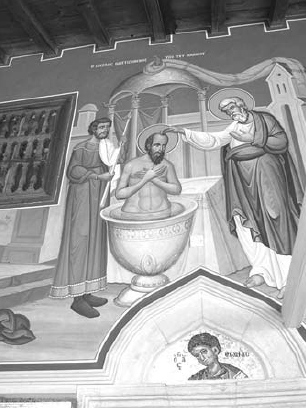
Baptism in the Grail, Cyprus
However, these skull cups are not always associated with wrathful deities; they are also seen with gods such as Padmasambhava, who holds the "skull cup," which is described as holding an ocean of nectar (Elixir) that floats in the longevity vase.
So, almost immediately we have a clue to the contents of this receptacle and its real purpose - the Elixir. This Elixir was at the heart of many secret orders and was one of the carrots used to entice people to join.
But it was more than the contents that were of importance. The selection of the right skull was paramount, and the users were looking for Tantric powers or energy. Therefore a violent death would always be better, such as decapitation. The symbolism of the Tantric Skull Cups is very similar to that of the Holy Grail in that they are symbolic of immortality.
Even some western alchemical writings advise the use of skull cups in the process of the "great work," which is of course the search for the Elixir of Life. We find again and again that the "energy" spoken of in relation to these skull cups is exactly the same as the "serpent energy" or "fire" that secret societies across the world search for and claim to be able to manipulate.
The Tantric Skull Cups are said to parallel the clay pots of the Vedic sacrifices and the begging bowl of Buddha, which I found in at least one myth contained the serpent. 1
The skulls are said to serve as a constant reminder of death. The contents of the skulls are often blood, but also the blood of Rudra - the "Lord of wild animals" similar to Cernunnos.
Rudra's etymological origins are uncertain. It could mean "the red one" or "the weeper," or derive from the Syrian "Rhad" meaning serpent. In other areas it also means the "removal of pain" or "healer." Rudra is identified with Siva, and he is the divine healer.
Mahadeva, one of Siva's names, is often represented with a snake entwined around his neck, arms, and hair. His consort, Parvati, is likewise represented. Bhairava, the Avatar of Siva, sits upon the coils of a serpent, whose "head rises above that of the gods."
Also, according to Hyde Clarke and C. Staniland Wake in Serpent and Siva Worship, Siva is the same as Rudra, the healer, and is called the King of Serpents.
He is depicted with a garland of skulls, symbolizing time measured in years, the changing of ages. He is called sometimes Nagabhushana Vyalakalpa or "having serpents round his neck" and Nagaharadhrik or "wearing serpent-necklaces" and also Nagaendra. Nagesha or "king of Nagas" is also known as Nakula, the "mongoose" which means one who is immune from the venom of the snake.
Siva is also seen as a "horned god" and is connected with the serpent worship in many ways. Both Siva and "Siva in the form of Rudra" are seen in their dynamic aspect as being entwined with serpents. These are serpent deities of old and are connected here with the cup of the head, bringing several disparate elements together - the skull, the grail, the mind, the snake, and time or immortality.
They are regenerative serpent deities offering longevity via their blood within a cup. In essence, what we have here is the serpent, which resides within the mind and therefore skull, which gives us all those things that Grail is said to give.
But can any of this relate further away in time and space and arrive in Europe, the supposed true home of the Holy Grail?
Livy in Historae mentions a similar Celtic operation from the 3rd century A.D., which simply must be connected to the Indian skull cups.
Apparently when the Boii tribe got hold of a victim, they,
"cut off the head, and carried their spoils in triumph to the most hallowed of their temples. There they cleaned out the head, as is their custom, and gilded the skull, which thereafter served them as a holy vessel to pour libations from and as a drinking cup for the priest and the temple attendants."
The sacred water used in the skull cups was often taken from a holy well, which, as I have established elsewhere, 2 were places linked intrinsically with the worship of the ancient serpent.
The idea here is that this ritual practice goes back beyond even the total memory recall of the Celts to a time when the cups employed the real power of the serpent, not just symbolic water. In essence, the water, whether of wells, lakes, pools, or seas, was seen by man across the globe as an entryway or portal into the Otherworld. Taking this otherworldly water in a sacred cup fuses a special power into the water - no different to the Holy Water taken from the font in any Christian church.
The etymology of the skull gives some interesting insights.
In Old German it is Scala, which is also a seashell; the symbol used by pilgrims on their way to the shrine of St. James in Spain - a symbol of life.
Old Norse it is Skel, which means "to have scales" or be "scale-like." The word skoal, now a fairly common drinking cry, is also closely related and means to "toast from a skull."
This etymology alone shows the deep-seated element of the skull in Western Europe and its use as a drinking vessel. Remarkably, skoal was also used to refer to a chalice! (The Ukranian word Cherep refers both to skull and chalice.)
We must not forget the Christian Messiah was also crucified at the "place of the skull," Golgotha. That is, his sacrificial blood was spilled into the skull!
But there is more to this than meets the eye.
This place, Golgotha, is also connected to the sign Capricorn - the half-goat, half-fish, or serpent. Capri is from Latin, meaning "goat" or "head," and corn is "horn."
This then, is the "horn of the head" or "goat" - the Golgotha.

Christ crucified at Golgotha, Kykkoss Monastery, Cyprus
So Jesus spilled his blood into the secret Grail on that fateful day - the secret Grail being the horn or cup of the skull.
Just as the serpent blood is found in the skull cups, so too is the blood of Jesus.
Now we can see why the Templars' infamous Baphomet head 3 was seen as a skull and a goat; it was a hidden mystery - a mystery which has been misunderstood ever since. The Brazen Serpent, the healing snake of Moses now seen as Christ in the New Testament, was lifted up at the place of the skull and his offering of blood 4 was collected - the ultimate sacrifice on the tree of life for the ultimate prize of immortality.
But truly, if Christ is all and in all, as we are told by the Bible, then we can all obtain this immortality of the one, the shaman deity or Jesus, who visited the Otherworld.
Jesus went down into hell for us, we are told; the shaman would enter a trance, drink from the skull cup, and visit the Otherworld for us; the priests of Egypt, South America, and the Celtic lands would do the same. This then is a universal experience expressed in symbolic form via the skull. The reason is clear, because the mind resides within the skull; the Tantric power and the perceived wisdom of the united serpent energies all act within the skull. No wonder it was cut off, turned upside down, and gilded.
But is there any more evidence showing this remarkable symbolism?
There is a Naga 5 myth that relates to the place of the skull. It is about Padmasambhava (Guru Rinpoche) or simply Padma. He is revered in many places, and in Tibet held alongside Buddha; indeed, many see him as the "second coming" of Buddha.
He is inseparable from the primordial Buddha. He was "in the beginning," the way Jesus was "the Word."
He received the wish-fulfilling jewel from the daughter of a Naga king and used it to restore sight and make riches. He is said to have transformed himself into a demon by tying a snake into his hair, and practiced a secret language to enable the Nagas to assist him. He spoke to those who had ears to hear; Arjuna (John) taught him astrology and he learned all about medicine from Jivakakumara.
While Padma was practicing his skills in a cemetery, Garab Dorje was born to a virgin daughter of King Dharmasoka. Now, please don't try this at home, but she had no use for the bastard son and so tossed him into a burning pit; but the child survived. Then she remembered a dream in which she gave birth to a celestial being, so she pulled him from the pit after seven days 6 and, finding him alive, called him Rolang Dewa.
During the child's early years he learned many wise things and debated against 500 great pandits who all said he was the Buddha.
Padma then came, as a wise man and (very much as John the Baptist did to Jesus) taught Garab Tantras. Padma then went on to seek the secret of longevity and was directed to Kungamo, who dwelt in the palace of skulls.
Kungamo turned Padma into a syllable, like Jesus as the word, and swallowed him. Inside the stomach he found the secrets he was searching for.
Padma is often seen holding a cup filled with the divine liquor, which he offers to his disciples - saying "drink of this to attain liberation."
Padma then is linked to the Naga serpent cult, to healing, to the Elixir via the palace of skulls. He is the word; the teacher of the Christ, like Garab who was born of a virgin; and he gives the Eucharist cup to his disciples. All of this is a symbolic representation of the almost exact process an initiate into the mysteries of secret societies must go through. It is a parable of the pathway.
In all respects, this wonderful stylized Indian tale has all the elements we could possibly require to show that the Christian and medieval Grail stories are nothing more than a retelling of much more ancient concepts, and that these concepts revolve around a universal and archetypal truth. This truth is that our own immortality and our own salvation lies within our own minds.
Secret orders that teach these processes remain in the world today. Some teach the truths through Eastern methods and others have Westernized them, but all speak of the truth that is inside our own skulls.
Now you know the truth; will it set you free?
Notes
1. Kashyapa warned Buddha that there was only one hut available, and that a malevolent Naga occupied it. Buddha was not phased by this and went to the hut regardless. However, a terrific struggle ensued culminating in the hut bursting into flames. The onlookers drenched the flames, but they had to wait until morning to find that Buddha had survived. The Buddha emerged with his begging bowl in his arms and inside was a peaceful, coiled snake. The Buddha had slain the dragon of its fiery notions and emerged with a beneficial result.
2. See The Serpent Grail by Philip Gardiner with Gary Osborn (Watkins), 2005.
3. Baphe means to submerge, metis means wisdom, and therefore Baphomet could simply mean “to be submerged in wisdom.”
4. The blood of course is seen the world over as the life force, or life energy of the body. It was sacred to the Hebrews especially, but not in isolation.
Christ spilling his almost Tantric energy into the place of the skull is therefore invigorating the skull into which it falls - making Golgotha a very sacred place or relic.
5. The Nagas are serpent worshippers from India.
6. The seven days are of course an allusion to the seven levels of the coiled serpent, or kundalini awakening, whereby the serpent energies are visualized and raised in balance into the head, and one becomes a Buddha or enlightened one.














-
Urantia Book, 44:0.11 - The Celestial Artisans
Never in your long ascendancy will you lose the power to recognize your associates of former existences. Always, as you ascend inward in the scale of life, will you retain the ability to recognize and fraternize with the fellow beings of your previous and lower levels of experience. Each new translation or resurrection will add one more group of spirit beings to your vision range without in the least depriving you of the ability to recognize your friends and fellows of former estates.
-
Princess Bride 1987 Wallace Shawn (Vizzini) and Mandy Patinkin (Inigo Montoya)
Vizzini: HE DIDN'T FALL? INCONCEIVABLE.
Inigo Montoya: You keep using that word. I do not think it means what you think it means. -
Urantia Book, 117:4.14 - The Finite God
And here is mystery: The more closely man approaches God through love, the greater the reality -- actuality -- of that man. The more man withdraws from God, the more nearly he approaches nonreality -- cessation of existence. When man consecrates his will to the doing of the Father's will, when man gives God all that he has, then does God make that man more than he is.
-
Urantia Book, 167:7.4 - The Talk About Angels
"And do you not remember that I said to you once before that, if you had your spiritual eyes anointed, you would then see the heavens opened and behold the angels of God ascending and descending? It is by the ministry of the angels that one world may be kept in touch with other worlds, for have I not repeatedly told you that I have other sheep not of this fold?"
-
Urantia Book, Foreword - 0:12.12 - The Trinities
But we know that there dwells within the human mind a fragment of God, and that there sojourns with the human soul the Spirit of Truth; and we further know that these spirit forces conspire to enable material man to grasp the reality of spiritual values and to comprehend the philosophy of universe meanings. But even more certainly we know that these spirits of the Divine Presence are able to assist man in the spiritual appropriation of all truth contributory to the enhancement of the ever-progressing reality of personal religious experience—God-consciousness.
-
Urantia Book, 1:4.3 - The Mystery Of God
When you are through down here, when your course has been run in temporary form on earth, when your trial trip in the flesh is finished, when the dust that composes the mortal tabernacle "returns to the earth whence it came"; then, it is revealed, the indwelling "Spirit shall return to God who gave it." There sojourns within each moral being of this planet a fragment of God, a part and parcel of divinity. It is not yet yours by right of possession, but it is designedly intended to be one with you if you survive the mortal existence.
-
Urantia Book, 1:4.1 - The Mystery Of God
And the greatest of all the unfathomable mysteries of God is the phenomenon of the divine indwelling of mortal minds. The manner in which the Universal Father sojourns with the creatures of time is the most profound of all universe mysteries; the divine presence in the mind of man is the mystery of mysteries.
-
Urantia Book, 1:4.6 - The Mystery Of God
To every spirit being and to every mortal creature in every sphere and on every world of the universe of universes, the Universal Father reveals all of his gracious and divine self that can be discerned or comprehended by such spirit beings and by such mortal creatures. God is no respecter of persons, either spiritual or material. The divine presence which any child of the universe enjoys at any given moment is limited only by the capacity of such a creature to receive and to discern the spirit actualities of the supermaterial world.
-
Urantia Book, 11:0.1 - The Eternal Isle Of Paradise
Paradise is the eternal center of the universe of universes and the abiding place of the Universal Father, the Eternal Son, the Infinite Spirit, and their divine co-ordinates and associates. This central Isle is the most gigantic organized body of cosmic reality in all the master universe. Paradise is a material sphere as well as a spiritual abode. All of the intelligent creation of the Universal Father is domiciled on material abodes; hence must the absolute controlling center also be material, literal. And again it should be reiterated that spirit things and spiritual beings are real.
-
Urantia Book, 50:6.4 - Planetary Culture
Culture presupposes quality of mind; culture cannot be enhanced unless mind is elevated. Superior intellect will seek a noble culture and find some way to attain such a goal. Inferior minds will spurn the highest culture even when presented to them ready-made.
-
Urantia Book, 54:1.6 - True And False Liberty
True liberty is the associate of genuine self-respect; false liberty is the consort of self-admiration. True liberty is the fruit of self-control; false liberty, the assumption of self-assertion. Self-control leads to altruistic service; self-admiration tends towards the exploitation of others for the selfish aggrandizement of such a mistaken individual as is willing to sacrifice righteous attainment for the sake of possessing unjust power over his fellow beings.
-
Urantia Book, 54:1.9 - True And False Liberty
How dare the self-willed creature encroach upon the rights of his fellows in the name of personal liberty when the Supreme Rulers of the universe stand back in merciful respect for these prerogatives of will and potentials of personality! No being, in the exercise of his supposed personal liberty, has a right to deprive any other being of those privileges of existence conferred by the Creators and duly respected by all their loyal associates, subordinates, and subjects.
-
Urantia Book, 54:1.8 - True And False Liberty
There is no error greater than that species of self-deception which leads intelligent beings to crave the exercise of power over other beings for the purpose of depriving these persons of their natural liberties. The golden rule of human fairness cries out against all such fraud, unfairness, selfishness, and unrighteousness.




